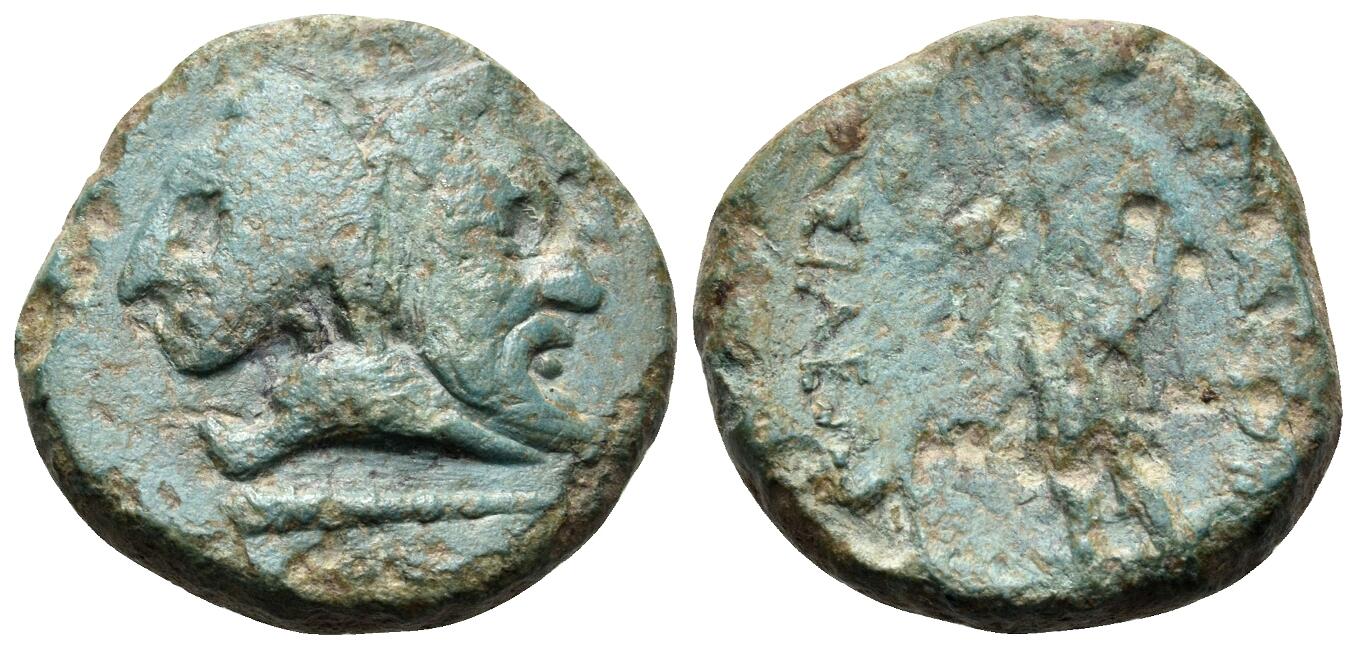H 89 - Cabyle (Spartokos), bronze (Janiform head/Artemis) (281-277 BCE)
From SILVER
(Redirected from H 89 - Cabyle (Spartokos), bronze, 3.70g (281-277 BCE))
281 BCE - 277 BCE Bronze
Description
| ObverseInscription or printing placed on the obverse.: | Janiform head of lion left, with open jaws, and bearded male right, club to left below |
| ReverseInscription or printing placed on the reverse.: | ΒΑΣΙΛΕΩΣ ΣΠΑΡΤΟΚΟΥ (Greek).Artemis standing left, holding wreath in right hand |
Mint and issuing power
| MintIdentifies the place of manufacture or issue of a numismatic object.: | Cabyle | Ancient regionAncient region.: | Thrace | Modern countryModern country: Bulgaria | AuthorityIdentifies the issuing power. The authority can be "pretended" when the name or the portrait of X is on the coin but he/she was not the issuing power. It can also be "uncertain" when there is no mention of X on the coin but he/she was the issuing power according to the historical sources: | Spartocus of Thrace (king of the Odrysian Kingdom, c. 281-278 BC) |
Chronology
| FromIdentifies the initial date in a range assigned in a numismatic context. | 281 BCE | toIdentifies the final date in a range assigned in a numismatic context.. | 277 BCE | PeriodTime period of the numismatic object.: Hellenistic 323-30 BC |
Physical description
| MetalThe physical material (usually metal) from which an object is made.: | Bronze |
Median weightMedian of the weights of numismatic objects (in grams). in grams | 3.70 | DenominationTerm indicating the value of a numismatic object. Examples: tetradrachm, chalkous, denarius.: | StandardStandard.: |
Image

RQEMH 89 - Cabyle, bronze, NC, 281-277 BC.jpg [1]
References
| Die study referencePublication of the study: | Draganov 19931Draganov 1993, n° 1-26. | ||
| Coin series referenceReference to coin series study: | RQEMH2RQEMH, n° 89 | ||
Obverse dies distribution
| FrequencyFrequency of specimen in distribution. ᵖ | Number of obversesNumber of obverse dies. ᵖ (o) | % (o) | Number of coinsNumber of coins. (n) | % (n) | Die nameName(s) of the die(s). |
| 1 | 1 | 50 | 1 | 4.17 | 2 |
| 23 | 1 | 50 | 23 | 95.83 | 1 |
| Total | 2 of 2 | 100 | 24 of 24 | 100 |
Reverse dies distribution
no distribution is available
Quantification
| Number of obversesNumber of obverse dies. ᵖ (o) | 2 | Number of singletons (o1)The number of singleton coins. ᵖ | 1 |
| Number of reverse diesNumber of reverse dies. (r) | 3 | Number of coinsNumber of coins. (n) | 24 |
| Coins per obverse dieNumber of coins per obverse die. (n/o) | 12 | Coins per reverse dieNumber of coins per reverse die. (n/r) | 8 |
| Reverse per obverse ratioRatio of obverse dies divided by reverse dies. (r/o) | 1.5 | Percentage of singletons (o1)number of coins (n) divided by the number of singletons (o1) ᵖ | 50 % |
| Original number of dies (O) (Carter 1983 formula)The estimation of the number of coins according to Carter 1983 ᵖ | 2 | Coins struck if 20,000 as average productivity per dieCoins made if the average productivity for obverses (according to Carter) is 20,000. ᵖ | 40,000 |
| Original number of dies (O) (Esty 2011 formula)The estimation of the number of coins according to the singleton formula in Esty 2011 ᵖ (O) | 2.18 | Survival rate if 20,000 as average productivity per dieSurvival rate if average productivity is 20,000. ᵖ | 0.00060 |
| Coverage (o = % of O) (Esty 1984 formula)Esty 1984 - coverage (% of O) ᵖ (o = % of O) | 95.83% | Die productivity if survival rate 1/2,000Average productivity if survival rate is 1/2,000. ᵖ | 24,000 |
| Weight of silver (in kg) if 20,000 coins per die (O = Carter formula)Carter 1983 * Median weight * 20000 (*10 if gold or electrum) ᵖ | n.a. | Die productivity if survival rate 1/5,000Average productivity if survival rate is 1/5,000. ᵖ | 60,000 |
Remarks
Most likely one single workstation